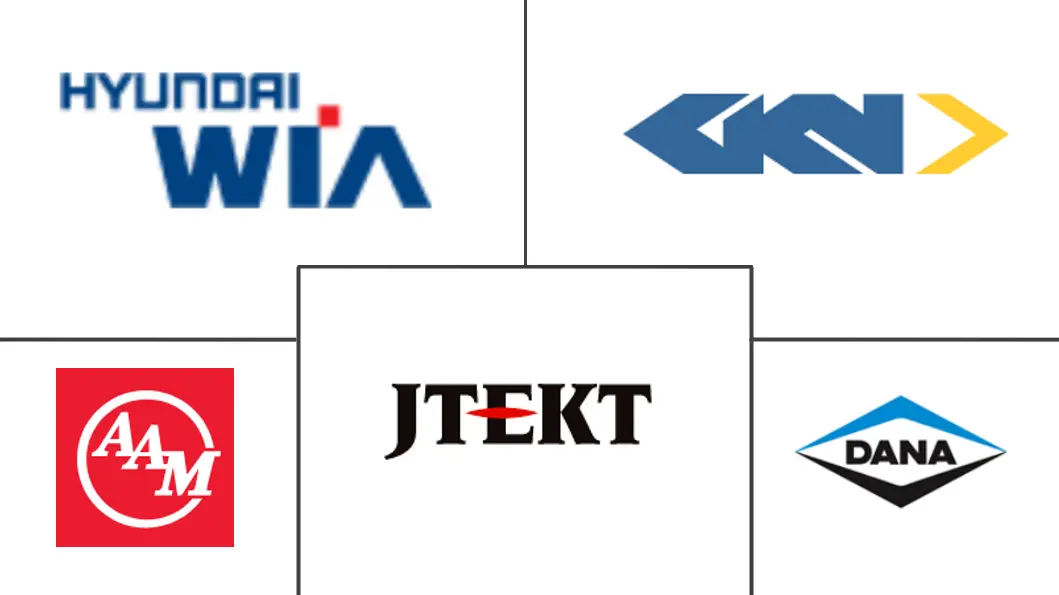Automotive Drive Shaft Market Size and Share
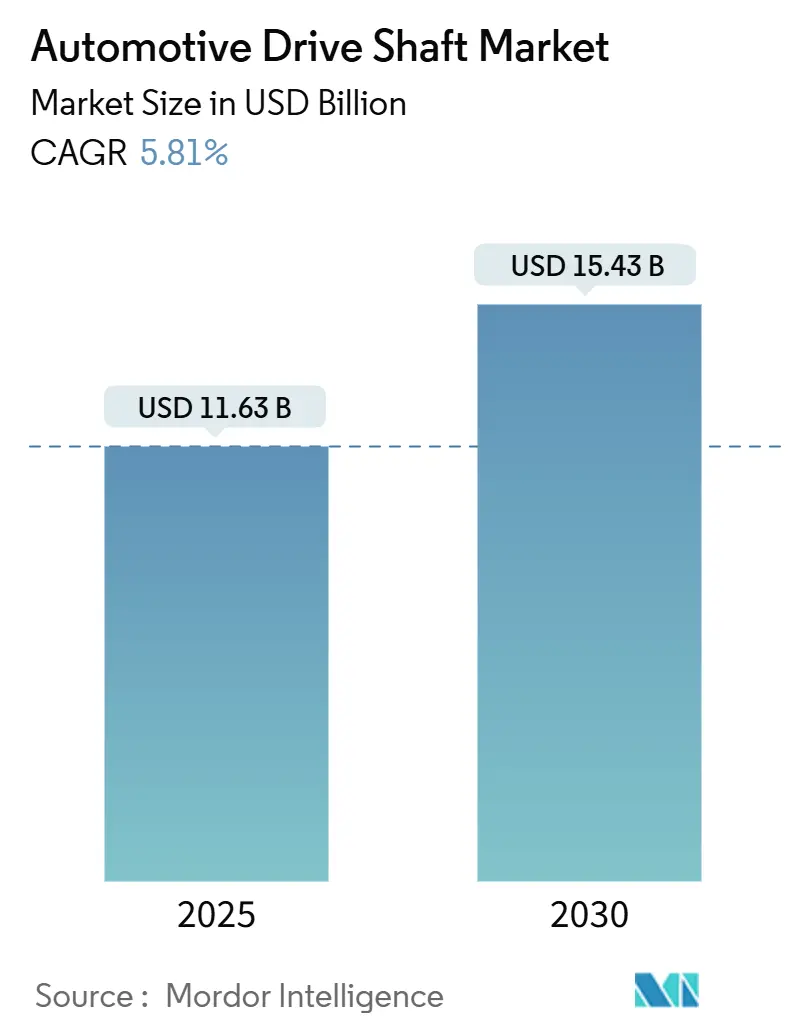
Automotive Drive Shaft Market Analysis by Mordor Intelligence
The global automotive drive shaft market was USD 11.63 billion in 2025 and projected to reach USD 15.43 billion by 2030, expanding at a 5.81% CAGR during the forecast period. This growth trajectory reflects the market's adaptation to electrification demands while maintaining robust performance in traditional powertrains. The transition from multi-piece conventional shafts to high-precision lightweight alternatives creates both disruption and opportunity, as OEMs balance cost pressures with performance requirements across diverse vehicle architectures.
Key Report Takeaways
- By design type, hollow shafts led with 57.12% revenue share in 2024; composite/CFRP shafts are forecast to expand at 12.95% CAGR through 2030.
- By material, conventional steel held 68.05% of the automotive drive shaft market share in 2024, while carbon-fiber/CFRP shafts are projected to grow at a 14.78% CAGR to 2030.
- By position, rear axle shafts commanded a 63.08% share of the automotive drive shaft market size in 2024; inter-axle/propeller shafts are advancing at a 11.33% CAGR through 2030.
- By vehicle type, passenger cars captured 72.48% revenue share in 2024; battery electric vehicles are projected to expand at 14.25% CAGR to 2030.
- By powertrain, ICE applications accounted for 82.03% of the automotive drive shaft market size in 2024, while battery electric vehicles are accelerating at a 14.05% CAGR through 2030.
- By sales channel, OEMs held 88.02% share in 2024, whereas the aftermarket is set to grow at 9.73% CAGR through 2030.
- By geography, Asia-Pacific led with 46.07% revenue share in 2024; Middle-East and Africa is recording the highest projected CAGR at 8.95% through 2030.
Global Automotive Drive Shaft Market Trends and Insights
Drivers Impact Analysis
| Driver | (~) % Impact on CAGR Forecast | Geographic Relevance | Impact Timeline |
|---|---|---|---|
| E-Axle Integration in BEVs Reduces Need for Multi-Piece Shafts but Drives Demand for High-Precision Lightweight Prop-Shafts | +1.2% | Global, concentrated in China, Europe, North America | Medium term (2–4 years) |
| Rapid Adoption of Carbon-Fiber Composite Shafts in Performance and Premium Vehicles | +0.8% | North America and Europe, expanding to Asia-Pacific premium segments | Long term (≥ 4 years) |
| Increasing Government Incentives for Local Lightweight-Material Manufacturing | +0.6% | North America, Europe, India, Southeast Asia | Short term (≤ 2 years) |
| Shift Toward Rear-Wheel-Based AWD for SUVs in North America and Europe | +0.9% | North America and Europe | Medium term (2–4 years) |
| Booming CV Production in ASEAN and Africa Industrial Corridors | +1.0% | ASEAN, Africa | Medium term (2–4 years) |
| Over-the-Air Driveline Analytics Unlocking Predictive-Maintenance Retrofits | +0.7% | Global | Long term (≥ 4 years) |
| Source: Mordor Intelligence | |||
E-axle Integration Reshapes Shaft Architecture
E-axle integration fundamentally alters drive shaft requirements by eliminating traditional multi-piece configurations while creating demand for high-precision lightweight propeller shafts in rear-wheel-drive electric architectures. Tesla's Model S Plaid and BMW iX demonstrate how integrated motor-gearbox units reduce component count yet require specialized carbon-fiber propeller shafts for torque vectoring applications. This architectural shift explains why BEV segments grow at 14.25% CAGR despite potentially reducing per-vehicle shaft content. Schaeffler's April 2025 production launch of ball screw drives for Chinese EV manufacturers illustrates how suppliers adapt precision manufacturing capabilities from traditional driveline applications to electric powertrains[1]"Schaeffler starts production of successful ball screw drive for Chinese EV manufacturer," Schaeffler Germany, schaeffler.de.. The transition creates opportunities for suppliers with advanced materials expertise while challenging traditional steel-focused manufacturers.
Carbon-Fiber Adoption Accelerates Beyond Premium Segments
Carbon-fiber composite shaft adoption extends beyond luxury applications into performance-oriented mainstream vehicles, driven by weight reduction mandates and NVH improvement requirements. Ford's latest F-150 variants and BMW's 3-Series incorporate carbon-fiber propeller shafts to achieve fuel economy targets while maintaining durability under high-torque conditions. The material's 60% weight reduction compared to steel enables longer shaft lengths without critical speed limitations, particularly valuable in AWD configurations where packaging constraints intensify. Manufacturing scale improvements reduce carbon-fiber shaft costs by approximately 15-20% annually, making adoption economically viable for volume applications beyond the traditional premium segment focus. This trend accelerates as OEMs prioritize lightweighting strategies to offset battery weight penalties in hybrid and electric powertrains.
Government Incentives Drive Localization
Government incentives for lightweight material manufacturing create regional supply chain advantages that reshape competitive dynamics in the drive shaft market. India's Production Linked Incentive (PLI) scheme allocates USD 3.5 billion for automotive component manufacturing, specifically targeting advanced materials and precision manufacturing capabilities[2]"Government Scales Up PLI Budget to Accelerate Manufacturing," PIB, pib.gov.in. . The U.S. Section 48C tax credit program provides 30% investment credits for advanced automotive manufacturing, while Illinois's REV program offers additional state-level electric vehicle component production incentives. These policies encourage suppliers to establish regional manufacturing capabilities rather than relying on import-dependent supply chains, particularly relevant for carbon-fiber and aluminum shaft production, where transportation costs significantly impact total landed costs.
AWD Proliferation Drives Inter-Axle Demand
The shift toward rear-wheel-based all-wheel-drive systems in North American and European SUVs creates sustained demand for inter-axle propeller shafts, growing at 11.33% CAGR through 2030. This architectural preference stems from improved towing capacity and performance characteristics compared to front-wheel-drive-based AWD systems. General Motors' latest Tahoe and Suburban models, along with Ford's Expedition lineup, demonstrate how full-size SUVs increasingly adopt rear-biased AWD configurations that require robust propeller shaft assemblies. The trend extends to premium crossover segments where brands like BMW X5 and Mercedes GLE prioritize rear-wheel-drive dynamics with on-demand front axle engagement, necessitating sophisticated inter-axle shaft systems with integrated disconnect capabilities.
Restraints Impact Analysis
| Restraint | (~) % Impact on CAGR Forecast | Geographic Relevance | Impact Timeline |
|---|---|---|---|
| Raw-Material (Carbon Fiber, Specialty Steel) Price Volatility | –0.7% | Global, acute in regions with limited local supply | Short term (≤ 2 years) |
| Supply-Chain Concentration of Precision Tube-Drawing in East Asia | –0.4% | Global, particularly affecting North America and Europe | Medium term (2–4 years) |
| Declining ICE Passenger-Car Sales in China and EU | –0.9% | China, EU | Medium term (2–4 years) |
| Warranty-Liability Risks from Composite Shaft Delamination | –0.6% | Global | Long term (≥ 4 years) |
| Source: Mordor Intelligence | |||
Raw Material Price Volatility Pressures Margins
Carbon fiber and specialty steel price volatility creates margin pressure across the drive shaft supply chain, with carbon fiber prices fluctuating 25-30% quarterly based on aerospace demand cycles and energy costs. The concentration of carbon fiber production among few global suppliers (Toray, SGL Carbon, Hexcel) creates supply bottlenecks when demand surges from aerospace recovery and renewable energy applications. Specialty steel grades used in high-performance applications face similar volatility, with chromium-molybdenum alloy prices increasing 18% in 2024 due to mining disruptions and geopolitical tensions affecting raw material supply. This volatility forces suppliers to implement dynamic pricing mechanisms and hedge strategies that complicate long-term OEM contracts, potentially slowing adoption of advanced materials in cost-sensitive applications.
Supply Chain Concentration Creates Vulnerability
The concentration of precision tube-drawing capabilities in East Asia, particularly South Korea and Japan, creates supply chain vulnerabilities for global drive shaft production. Approximately 70% of high-precision seamless steel tubes used in automotive applications originate from facilities operated by companies like POSCO and JFE Steel, creating single points of failure for global supply chains. This concentration became evident during COVID-19 disruptions when automotive production delays extended 8-12 weeks due to tube supply shortages. The geographic concentration also creates logistics challenges and extended lead times for North American and European manufacturers, adding 4-6 weeks to production cycles compared to regionally sourced alternatives.
Segment Analysis
By Design Type: Hollow Dominance Faces Composite Challenge
Hollow shafts command 57.12% market share in 2024, reflecting their optimal balance of weight reduction and manufacturing cost efficiency compared to solid alternatives. The design's advantages include 40-50% weight reduction versus solid shafts while maintaining equivalent torque capacity through optimized wall thickness engineering. Composite/CFRP shafts accelerate at 12.95% CAGR through 2030, driven by premium vehicle adoption and performance applications where weight savings justify higher material costs. Two-piece/slip-in tube configurations serve specific packaging requirements in compact vehicle architectures, particularly in front-wheel-drive applications where space constraints limit single-piece shaft installation.
Solid shaft applications persist in heavy-duty commercial vehicles and off-road applications where durability requirements outweigh weight considerations. The segment's stability reflects commercial vehicle manufacturers' conservative approach, prioritizing proven reliability over advanced materials. Manufacturing innovations in hollow shaft production, including hydroforming and advanced welding techniques, continue to expand the design's applicability across vehicle segments while maintaining cost competitiveness against solid alternatives.
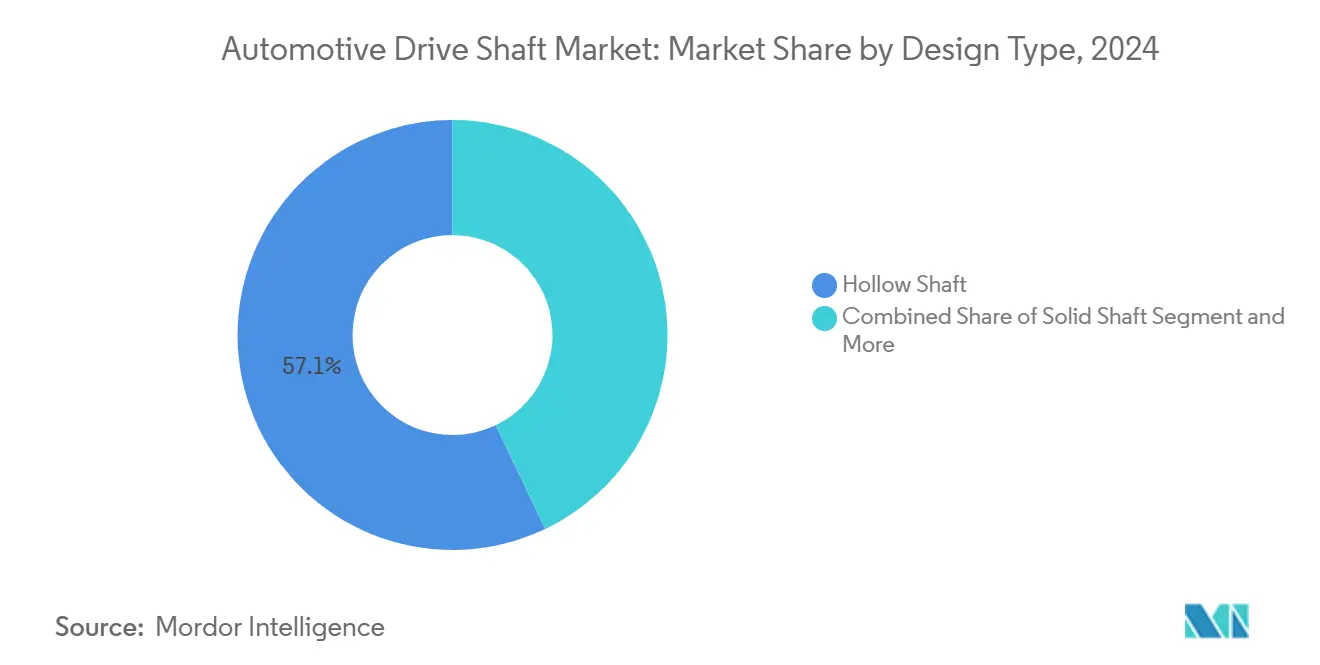
Note: Segment shares of all individual segments available upon report purchase
By Material: Steel Dominance Challenged by Lightweighting
Conventional steel maintains 68.05% market share in 2024, reflecting its cost-effectiveness and established manufacturing infrastructure across global supply chains. However, carbon-fiber/CFRP materials surge at 14.78% CAGR through 2030, indicating a fundamental shift toward lightweight solutions that extends beyond premium applications. High-strength alloy steel serves intermediate applications where weight reduction requirements exceed conventional steel capabilities but cost constraints limit carbon-fiber adoption. Aluminum applications focus on specific use cases where corrosion resistance and moderate weight reduction justify the material premium over steel alternatives.
The material transition reflects broader automotive lightweighting mandates driven by fuel economy regulations and electric vehicle range optimization. Carbon-fiber manufacturing scale improvements, including automated fiber placement and resin transfer molding, reduce production costs while improving quality consistency. This technological advancement enables carbon-fiber adoption in volume applications previously dominated by steel, particularly in propeller shaft applications where length and critical speed requirements favor lightweight materials.
By Position Type: Rear Axle Leadership with AWD Growth
Rear axle shafts dominate with 63.08% market share in 2024, reflecting the prevalence of rear-wheel-drive architectures in commercial vehicles and performance applications. Inter-axle/propeller shafts for AWD systems represent the fastest-growing segment at 11.33% CAGR, driven by SUV proliferation and all-wheel-drive adoption across vehicle segments. Front axle shafts maintain steady demand in front-wheel-drive applications, though growth moderates as vehicle architectures shift toward rear-biased configurations for improved performance characteristics.
Position-based segmentation reveals architectural preferences that influence shaft design requirements. Rear axle applications typically require higher torque capacity and durability, favoring conventional materials and proven designs. Inter-axle applications demand sophisticated engineering to accommodate variable torque distribution and disconnect mechanisms, creating opportunities for suppliers with advanced engineering capabilities. Nexteer Automotive's April 2025 expansion of driveline innovations demonstrates how suppliers adapt position-specific technologies to meet evolving architectural requirements.
By Vehicle Type: Passenger Car Dominance with BEV Disruption
Passenger cars command 72.48% market share in 2024, reflecting global vehicle production volumes and the segment's diverse powertrain configurations. Battery electric vehicles emerge as the fastest-growing segment at 14.25% CAGR, creating demand for specialized lightweight shafts despite potentially reducing overall shaft count per vehicle through e-axle integration. Light commercial vehicles maintain steady growth driven by e-commerce delivery demand and last-mile logistics expansion. Medium and heavy commercial vehicles provide stability through replacement demand and infrastructure development in emerging markets.
The vehicle type segmentation illustrates how electrification impacts differ across applications. Passenger car electrification accelerates rapidly, creating demand for lightweight propeller shafts in rear-wheel-drive electric architectures while eliminating traditional multi-piece configurations. Commercial vehicle electrification progresses more gradually due to payload and range constraints, maintaining demand for conventional shaft designs. China's February 2025 vehicle production data shows 888,000 new energy vehicles produced, representing 91.5% year-over-year growth, indicating the scale of electrification's impact on driveline component demand[3]"China - Flash report, Automotive sales volume market data (brands, vehicle type), 2025," Marklines, marklines.com..
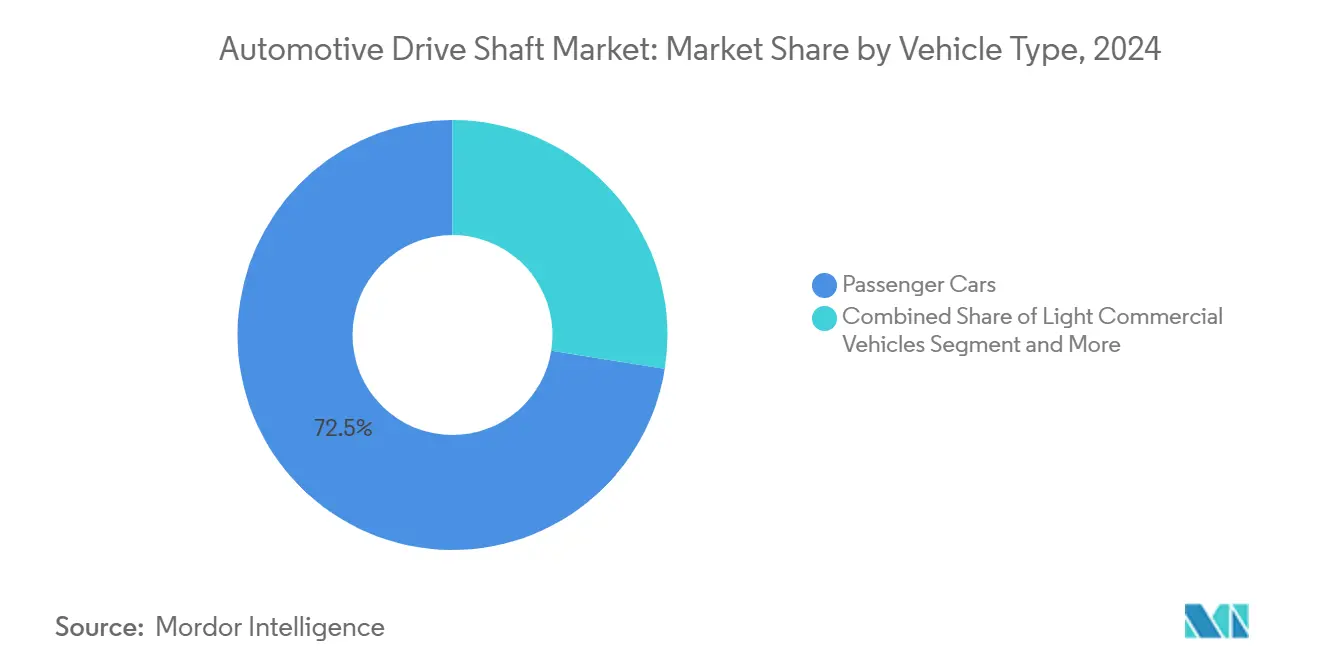
Note: Segment shares of all individual segments available upon report purchase
By Powertrain/Propulsion: ICE Stability Amid BEV Acceleration
Internal combustion engine applications maintain 82.03% market share in 2024, providing stability for traditional drive shaft designs and manufacturing processes. Battery electric vehicles accelerate at 14.05% CAGR through 2030, creating demand for specialized lightweight components while potentially reducing overall shaft content per vehicle. Hybrid applications (HEV and PHEV) serve as transitional technologies that maintain conventional driveline architectures while adding electric motor integration complexity.
The powertrain segmentation reflects the industry's gradual transition toward electrification while maintaining substantial conventional demand. ICE applications continue to drive volume production and established supply chain relationships, providing cash flow stability for suppliers investing in electric vehicle capabilities. BEV growth creates opportunities for suppliers with lightweight materials expertise and precision manufacturing capabilities, though the transition requires significant capital investment and technical adaptation. Europe's 2024 BEV sales decline of 1.3% to 1.99 million units demonstrates market volatility that affects supplier planning and investment decisions.
By Sales Channel: OEM Dominance with Aftermarket Resilience
Original equipment manufacturer (OEM) channels dominate with 88.02% market share in 2024, reflecting the drive shaft market's integration with vehicle production cycles and OEM specification requirements. Aftermarket segments grow at 9.73% CAGR through 2030, driven by extended vehicle lifecycles and maintenance-driven replacement demand that provides stability during production volatility. The aftermarket's growth reflects increasing vehicle age and complexity, creating demand for replacement components that maintain original performance specifications.
The sales channel dynamics illustrate the market's dual nature: OEM demand drives innovation and volume production, while aftermarket applications provide steady revenue streams less sensitive to production cycles. Aftermarket growth benefits from increasing vehicle complexity and performance requirements that necessitate OEM-equivalent replacement components rather than generic alternatives. This trend favors suppliers with strong brand recognition and technical capabilities that justify premium pricing in replacement applications.
Geography Analysis
Asia-Pacific dominates with 46.07% market share in 2024, driven by China's massive vehicle production scale and ASEAN's expanding commercial vehicle manufacturing capabilities. The region's growth stems from infrastructure development programs that boost commercial vehicle demand, particularly in Indonesia, Thailand, and Vietnam where industrial corridor development creates sustained freight transportation requirements. China's February 2025 commercial vehicle production of 318,000 units, representing 36.6% year-over-year growth, demonstrates the scale of demand driving regional shaft requirements. Regional suppliers benefit from proximity to major OEM production facilities and established supply chain relationships that reduce logistics costs and lead times.
North America and Europe represent mature markets with established automotive manufacturing bases that drive steady demand for drive shaft components across diverse vehicle segments. North American growth focuses on SUV and pickup truck segments where AWD proliferation creates demand for inter-axle propeller shafts, while European markets emphasize lightweight materials adoption driven by stringent emissions regulations. The regions' focus on premium applications and advanced materials creates opportunities for suppliers with carbon-fiber expertise and precision manufacturing capabilities. Government incentives in both regions support local manufacturing development, with the U.S. Section 48C program and European Union's Green Deal industrial policy encouraging domestic component production.
Middle-East and Africa emerges as the fastest-growing region at 8.95% CAGR through 2030, driven by infrastructure development programs and increasing vehicle ownership rates across the region. South Africa's automotive manufacturing expansion and UAE's logistics hub development create demand for commercial vehicle components, while oil-rich nations economic diversification programs support automotive assembly operations. The region's growth reflects broader industrialization trends that create sustained demand for transportation infrastructure and commercial vehicle fleets. However, the market is uneven across countries, with differing policy support and manufacturing capacity shaping growth trajectories.
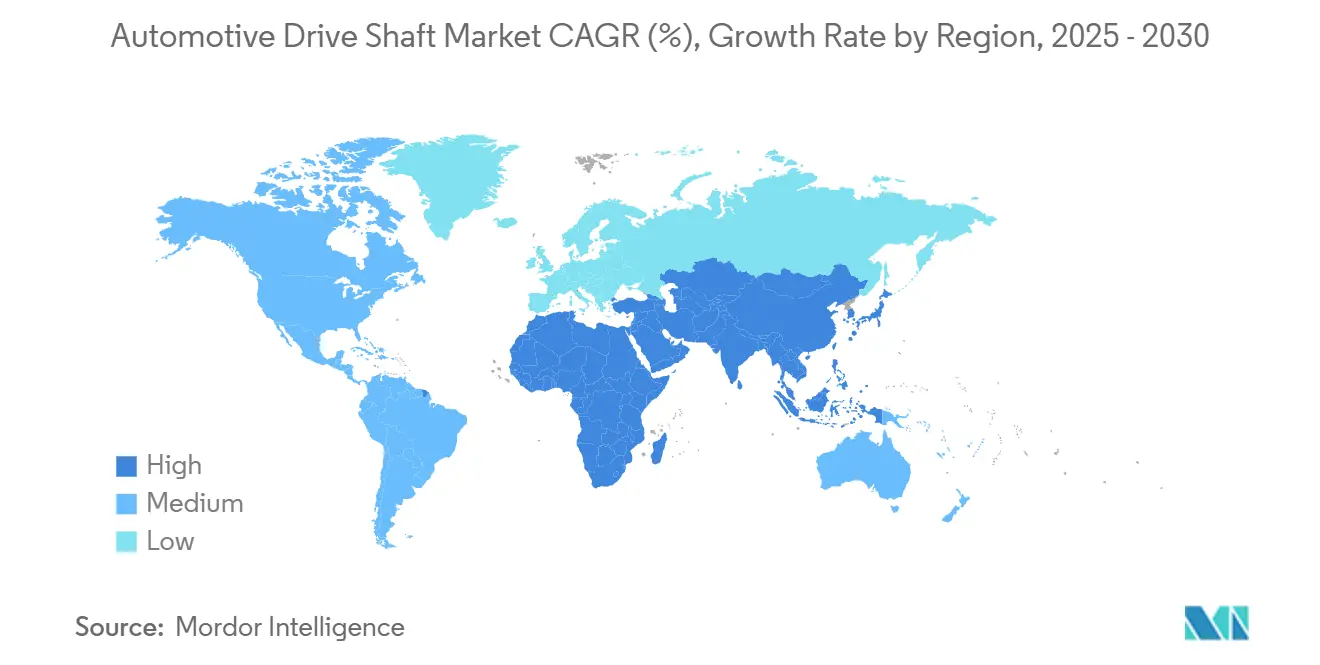
Competitive Landscape
The automotive drive shaft market exhibits moderate consolidation with tier-1 suppliers pursuing scale advantages through strategic acquisitions and vertical integration. American Axle & Manufacturing's USD 1.44 billion acquisition of Dowlais Group in January 2025 exemplifies this trend, creating a combined entity with projected annual revenues of USD 12 billion and targeted cost synergies of USD 300 million. The transaction combines AAM's forging capabilities with GKN Automotive's driveline expertise, positioning the merged entity as a global leader in powertrain-agnostic driveline technologies. Market concentration accelerates as suppliers seek scale economies to support R&D investments in lightweight materials and electric vehicle applications while maintaining competitiveness in traditional ICE segments.
Technology differentiation centers on materials science and manufacturing process innovation, with suppliers investing in carbon-fiber capabilities and automated production systems to serve premium applications. White-space opportunities exist in regional manufacturing localization, particularly in emerging markets where government incentives support domestic component production. Emerging disruptors include specialized carbon-fiber manufacturers entering automotive applications from aerospace backgrounds, leveraging advanced materials expertise to capture high-value segments. The competitive landscape increasingly favors suppliers with dual capabilities in conventional manufacturing and advanced materials, enabling them to serve diverse customer requirements across the electrification transition.
Automotive Drive Shaft Industry Leaders
-
Dana Incorporated
-
GKN PLC (Melrose Industries PLC)
-
JTEKT Corporation
-
Hyundai Wia Corporation
-
American Axle and Manufacturing Holdings Inc.
- *Disclaimer: Major Players sorted in no particular order
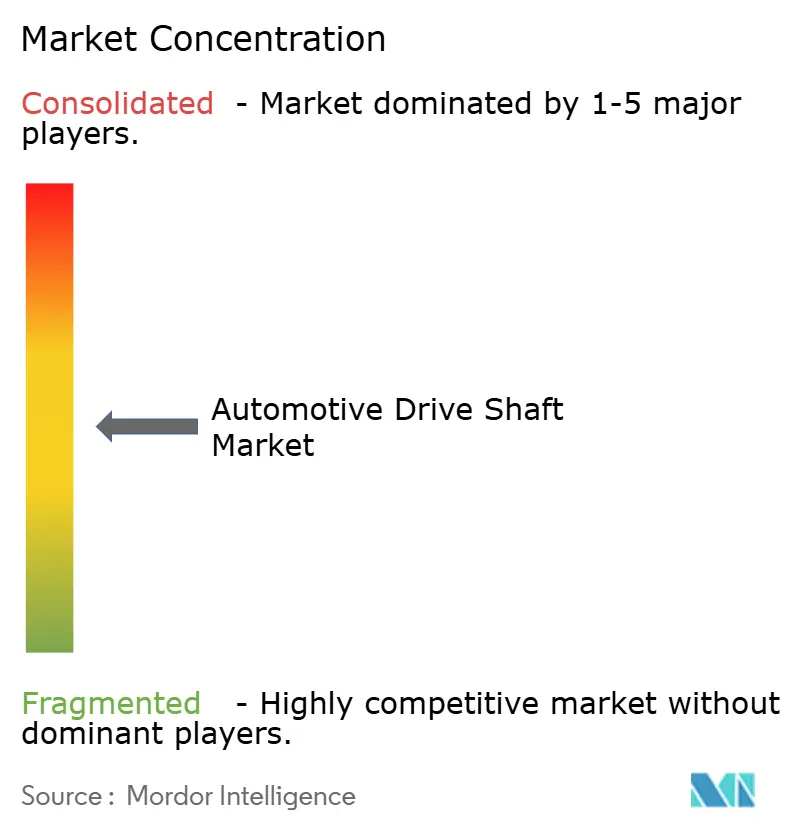
Recent Industry Developments
- January 2025: American Axle & Manufacturing announced a definitive agreement to acquire Dowlais Group plc (owner of GKN Automotive and GKN Powder Metallurgy) for USD 1.44 billion in cash and stock. The transaction creates a global driveline supplier with projected annual revenues of USD 12 billion and targeted cost synergies of USD 300 million, positioning the combined entity as a leader in powertrain-agnostic driveline technologies across ICE, hybrid, and electric vehicle applications.
- February 2024: JTEKT developed an ultra-compact product series covering Differential (JUCD), Ball Bearing (JUCB), Conductive Ball Bearing (JUEB), and Oil Seal (JUCS) for eAxle size and weight reduction.
Global Automotive Drive Shaft Market Report Scope
An automotive drive shaft or propeller shaft transfers the power produced by the engine from the transmission to the rear axle or front axle. The application of extruded aluminum in drive shafts has been the most notable for rear-wheel or all-wheel drive vehicles, both for the tubes and the Cardan links.
The automotive drive shaft market is segmented into design type, position type, vehicle type, sales channel, and geography. By design type, the market is segmented into hollow shafts and solid shafts. By position type, the market is segmented into rear axle and front axle. By vehicle type, the market is segmented into passenger cars and commercial vehicles. By sales channel, the market is segmented into OEM and aftermarket. By geography, the market is segmented into North America, Europe, Asia-Pacific, and Rest of the world.
The report offers market size and forecasts in value (USD) and volume (units) for all the above segments.
| Hollow Shaft |
| Solid Shaft |
| Two-piece/Slip-in Tube |
| Composite/Carbon-Fiber Shaft |
| Conventional Steel |
| High-Strength Alloy Steel |
| Aluminum |
| Carbon-Fiber/CFRP |
| Rear Axle Shafts |
| Front Axle Shafts |
| Inter-axle/Propeller Shafts for AWD |
| Passenger Cars |
| Light Commercial Vehicles |
| Medium and Heavy Commercial Vehicles |
| Internal Combustion Engine (ICE) |
| Hybrid (HEV and PHEV) |
| Battery Electric Vehicle (BEV) |
| OEM |
| Aftermarket |
| North America | United States |
| Canada | |
| Rest of North America | |
| South America | Brazil |
| Argentina | |
| Rest of South America | |
| Europe | Germany |
| United Kingdom | |
| France | |
| Italy | |
| Rest of Europe | |
| Asia-Pacific | China |
| Japan | |
| India | |
| South Korea | |
| Rest of Asia-Pacific | |
| Middle-East and Africa | United Arab Emirates |
| Saudi Arabia | |
| Egypt | |
| South Africa | |
| Rest of Middle-East and Africa |
| By Design Type | Hollow Shaft | |
| Solid Shaft | ||
| Two-piece/Slip-in Tube | ||
| Composite/Carbon-Fiber Shaft | ||
| By Material | Conventional Steel | |
| High-Strength Alloy Steel | ||
| Aluminum | ||
| Carbon-Fiber/CFRP | ||
| By Position Type | Rear Axle Shafts | |
| Front Axle Shafts | ||
| Inter-axle/Propeller Shafts for AWD | ||
| By Vehicle Type | Passenger Cars | |
| Light Commercial Vehicles | ||
| Medium and Heavy Commercial Vehicles | ||
| By Powertrain / Propulsion | Internal Combustion Engine (ICE) | |
| Hybrid (HEV and PHEV) | ||
| Battery Electric Vehicle (BEV) | ||
| By Sales Channel | OEM | |
| Aftermarket | ||
| By Geography | North America | United States |
| Canada | ||
| Rest of North America | ||
| South America | Brazil | |
| Argentina | ||
| Rest of South America | ||
| Europe | Germany | |
| United Kingdom | ||
| France | ||
| Italy | ||
| Rest of Europe | ||
| Asia-Pacific | China | |
| Japan | ||
| India | ||
| South Korea | ||
| Rest of Asia-Pacific | ||
| Middle-East and Africa | United Arab Emirates | |
| Saudi Arabia | ||
| Egypt | ||
| South Africa | ||
| Rest of Middle-East and Africa | ||
Key Questions Answered in the Report
How large is the automotive drive shaft market in 2025?
The market stands at USD 11.63 billion in 2025 with a forecast 5.81% CAGR to 2030.
Which region leads global demand?
Asia-Pacific holds 46.07% of revenue, buoyed by China’s high vehicle output and ASEAN truck growth.
What material segment is growing fastest?
Carbon-fiber/CFRP shafts are expanding at 14.78% CAGR as OEMs prioritize lightweighting.
How is electrification affecting shaft design?
E-axle architectures reduce component count but increase demand for high-precision lightweight rear shafts in BEVs.
What channel offers the highest growth opportunity?
The aftermarket is rising 9.73% CAGR as vehicle fleets age and require OEM-equivalent replacements.
Page last updated on:
